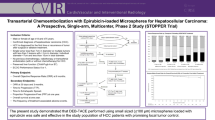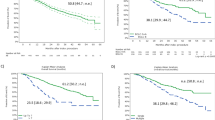Abstract
Background Transarterial chemoembolization using microspheres is a new treatment option for patients with hepatocellular carcinoma. Objective To assess the effectiveness of this technique, in terms of tumor response and overall survival rates, and to assess the procedure’s safety. Setting A General University Hospital in Spain. Methods Single-center retrospective observational study. The cohort included all patients treated between October 2006 and April 2010. Effectiveness was determined by the tumor response rate (using modified RECIST and EASL criteria) and overall survival. Safety was assessed according to the Common Terminology Criteria for Adverse Events. Main outcome measure Tumor response rate, overall survival and safety of transarterial chemoembolization in patients with hepatocelular carcinoma. Results 53 patients were treated (81.1 % men, median age 65). Baseline characteristics 98.1 % had cirrhosis, 75.5 % Child-Pugh Class A, 71.7 % Okuda I, and 94.3 % were ECOG 0. 43.4 % were waiting for a liver transplant and 56.6 % were given the treatment as a palliative measure. Eighty-one procedures were carried out, with a median of 1 per patient [1–5]. Four weeks after treatment, the objective response rate was 87.5 % and the complete response rate was 62.5 %. Median survival was 735 days (CI 95 %: 351.9–1118.1). The 1, 2 and 3-year overall survival rates were 65.4, 50.9 and 42.5 %, respectively. 71.7 % of patients experienced post-embolization syndrome, with grade 1 abdominal pain as the most frequent symptom (37.7 %). Conclusion This study provides new evidence of the safety and effectiveness of transarterial chemoembolization using doxorubicin-loaded microspheres for the treatment of hepatocellular carcinoma in patients who are not eligible for other treatments, or as a bridging treatment in patients on the liver transplant waiting list.

Similar content being viewed by others
References
Venook AP, Papandreou C, Furuse J, de Guevara LL. The incidence and epidemiology of hepatocellular carcinoma: a global and regional perspective. Oncologist. 2010;15(Suppl 4):5–13.
GLOBOCAN 2008, International Agency for Research of Cancer. Updated Jan 2009. Last cited 06-2013. Available from: http://globocan.iarc.fr/factsheets/populations/factsheet.asp?uno=900.
Ferlay J, Shin HR, Bray F, Forman D, Mathers C, Parkin DM. Estimates of worldwide burden of cancer in 2008: GLOBOCAN 2008. Int J Cancer. 2010;127(12):2893–917.
Bruix J, Sherman M. Management of hepatocellular carcinoma. Hepatology. 2005;42(5):1208–36.
Bosch FX, Ribes J, Borras J. Epidemiology of primary liver cancer. Semin Liver Dis. 1999;19(3):271–85.
Donato F, Tagger A, Gelatti U, Parrinello G, Boffetta P, Albertini A, et al. Alcohol and hepatocellular carcinoma: the effect of lifetime intake and hepatitis virus infections in men and women. Am J Epidemiol. 2002;155(4):323–31.
Fattovich G, Stroffolini T, Zagni I, Donato F. Hepatocellular carcinoma in cirrhosis: incidence and risk factors. Gastroenterology. 2004;127(5 Suppl 1):S35–50.
Vilana R, Forner A, Garcia A, Ayuso C, Bru C. Imaging diagnosis of hepatocellular carcinoma. Addendum to hepatocellular carcinoma: diagnosis, staging and treatment strategies. Radiologia. 2011;53(2):156–8.
NCCN Clinical Practice Guidelines in Oncology. Updated Oct 2011. Last cited 06-2013. Available from: http://www.nccn.org/professionals/physician_gls/pdf/hepatobiliary.pdf.
Bruix J, Sherman M. Management of hepatocellular carcinoma: An update. Hepatology. 2011;53(3):1020–2.
Eastern Cooperative Oncology Group. Updated Jul 2006. Last cited 06-2013. Available from: http://ecog.dfci.harvard.edu/general/perf_stat.html.
Bruix J, Sherman M, Llovet JM, Beaugrand M, Lencioni R, Burroughs AK, et al. Clinical management of hepatocellular carcinoma. Conclusions of the Barcelona-2000 EASL conference. European Association for the Study of the Liver. J Hepatol. 2001;35(3):421–30.
Robles R, Marin C, Lopez-Conesa A, Capel A, Parrilla P. Chemical embolisation before laparoscopic hepatic resection in early hepatocellular carcinoma in cirrhotic patients. Cir Esp. 2009;86(5):303–7.
Lencioni R, Llovet JM. Modified RECIST (mRECIST) assessment for hepatocellular carcinoma. Semin Liver Dis. 2010;30(1):52–60.
Llovet JM, Real MI, Montana X, Planas R, Coll S, Aponte J, et al. Arterial embolisation or chemoembolisation versus symptomatic treatment in patients with unresectable hepatocellular carcinoma: a randomised controlled trial. Lancet. 2002;359(9319):1734–9.
Varela M, Real MI, Burrel M, Forner A, Sala M, Brunet M, et al. Chemoembolization of hepatocellular carcinoma with drug eluting beads: efficacy and doxorubicin pharmacokinetics. J Hepatol. 2007;46(3):474–81.
Poon RT, Tso WK, Pang RW, Ng KK, Woo R, Tai KS, et al. A phase I/II trial of chemoembolization for hepatocellular carcinoma using a novel intra-arterial drug-eluting bead. Clin Gastroenterol Hepatol. 2007;5(9):1100–8.
Wigmore SJ, Redhead DN, Thomson BN, Currie EJ, Parks RW, Madhavan KK, et al. Postchemoembolisation syndrome–tumour necrosis or hepatocyte injury? Br J Cancer. 2003;89(8):1423–7.
Patel NH, Hahn D, Rapp S, Bergan K, Coldwell DM. Hepatic artery embolization: factors predisposing to postembolization pain and nausea. J Vasc Interv Radiol. 2000;11(4):453–60.
Malagari K, Chatzimichael K, Alexopoulou E, Kelekis A, Hall B, Dourakis S, et al. Transarterial chemoembolization of unresectable hepatocellular carcinoma with drug eluting beads: results of an open-label study of 62 patients. Cardiovasc Intervent Radiol. 2008;31(2):269–80.
Dhanasekaran R, Kooby DA, Staley CA, Kauh JS, Khanna V, Kim HS. Prognostic factors for survival in patients with unresectable hepatocellular carcinoma undergoing chemoembolization with doxorubicin drug-eluting beads: a preliminary study. HPB (Oxford). 2010;12(3):174–80.
Common Terminology Criteria for Adverse Events (CTCAE) v4.02. Updated May 2009. Last cited 06-2013. Available from: http://www.acrin.org/.
Lammer J, Malagari K, Vogl T, Pilleul F, Denys A, Watkinson A, et al. Prospective randomized study of doxorubicin-eluting-bead embolization in the treatment of hepatocellular carcinoma: results of the PRECISION V study. Cardiovasc Intervent Radiol. 2010;33(1):41–52.
Malagari K, Pomoni M, Spyridopoulos TN, Moschouris H, Kelekis A, Dourakis S, et al. Safety Profile of Sequential Transcatheter Chemoembolization with DC Bead™: Results of 237 Hepatocellular Carcinoma (HCC) Patients. Cardiovasc Intervent Radiol. 2011;34(4):774–85.
Forner A, Ayuso C, Isabel RM, Sastre J, Robles R, Sangro B, et al. Diagnosis and treatment of hepatocellular carcinoma. Med Clin (Barc). 2009;132(7):272–87.
Gomaa AI, Khan SA, Leen EL, Waked I, Taylor-Robinson SD. Diagnosis of hepatocellular carcinoma. World J Gastroenterol. 2009;15(11):1301–14.
Dharancy S, Boitard J, Decaens T, Sergent G, Boleslawski E, Duvoux C, et al. Comparison of two techniques of transarterial chemoembolization before liver transplantation for hepatocellular carcinoma: a case-control study. Liver Transpl. 2007;13(5):665–71.
Jelic S, Sotiropoulos GC. Hepatocellular carcinoma: ESMO clinical practice guidelines for diagnosis, treatment and follow-up. Ann Oncol. 2010;21(Suppl 5):v59–64.
Reyes DK, Vossen JA, Kamel IR, Azad NS, Wahlin TA, Torbenson MS, et al. Single-center phase II trial of transarterial chemoembolization with drug-eluting beads for patients with unresectable hepatocellular carcinoma: initial experience in the United States. Cancer J. 2009;15(6):526–32.
Malagari K, Alexopoulou E, Chatzimichail K, Hall B, Koskinas J, Ryan S, et al. Transcatheter chemoembolization in the treatment of HCC in patients not eligible for curative treatments: midterm results of doxorubicin-loaded DC bead. Abdom Imaging. 2008;33(5):512–9.
Ferrer P, la Parra C, Esteban E, Vano M, Forment M, Vera A, et al. Comparison of doxorubicin-eluting bead transarterial chemoembolization (DEB-TACE) with conventional transarterial chemoembolization (TACE) for the treatment of hepatocellular carcinoma. Radiologia. 2011;53(3):246–53.
Burrel M, Reig M, Forner A, Barrufet M, Lope CR, Tremosini S, et al. Survival of patients with hepatocellular carcinoma treated by transarterial chemoembolisation (TACE) using Drug Eluting Beads. Implications for clinical practice and trial design. J Hepatol. 2012;56(6):1330–5.
Sadick M, Haas S, Loehr M, Elshwi M, Singer MV, Brade J, et al. Application of DC beads in hepatocellular carcinoma: clinical and radiological results of a drug delivery device for transcatheter superselective arterial embolization. Onkologie. 2010;33(1–2):31–7.
Funding
None.
Conflicts of interest
None.
Author information
Authors and Affiliations
Corresponding author
Rights and permissions
About this article
Cite this article
Muros-Ortega, M., Díaz-Carrasco, M.S., Capel, A. et al. Effectiveness and safety of doxorubicin loaded beads in hepatocellular carcinoma. Int J Clin Pharm 35, 1105–1112 (2013). https://doi.org/10.1007/s11096-013-9831-7
Received:
Accepted:
Published:
Issue Date:
DOI: https://doi.org/10.1007/s11096-013-9831-7




